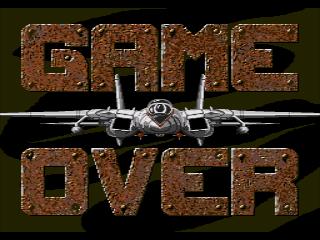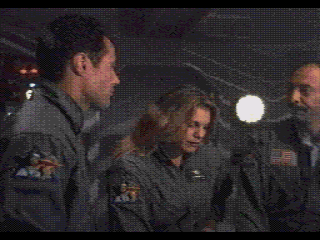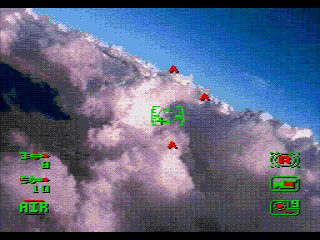Retro Replay Review
Gameplay
Tomcat Alley puts you in the pilot’s seat of an F-14 Tomcat, engaging in high-stakes dogfights against a variety of Soviet MiGs. The core mechanic revolves around watching live-action FMV sequences and making split-second decisions—whether to fire missiles, perform evasive maneuvers, or call in wingman support. Each choice branches the narrative slightly, ensuring your actions have tangible consequences in the heat of battle.
(HEY YOU!! We hope you enjoy! We try not to run ads. So basically, this is a very expensive hobby running this site. Please consider joining us for updates, forums, and more. Network w/ us to make some cash or friends while retro gaming, and you can win some free retro games for posting. Okay, carry on 👍)
The so-called Active Matrix software really shines here. Unlike many earlier FMV titles that felt linear and unresponsive, Tomcat Alley offers multiple outcomes for each aerial engagement. Succeeding on your first pass often leads to bonus missions or improved squadron morale, while mistakes can force you into emergency landings or more challenging rematches. This variability amps up replay value and keeps you on your toes.
Controls are straightforward: a few button presses at the right moment can mean the difference between shooting down a MiG or taking a missile to the tailpipe. Although you won’t be performing barrel rolls with a joystick, timing and strategic use of countermeasures feel surprisingly tactical. The balance between cinematic FMV and player interaction delivers a unique blend of reflex-driven excitement and strategic depth.
Graphics
As one of Sega CD’s TruVideo series, Tomcat Alley features real-world footage of jet fighters composited with cockpit overlays. The live-action sequences are grainy by today’s standards, yet they retain a gritty, analog charm that many retro enthusiasts will appreciate. The video compression artifacts are evident, but they lend authenticity to the 1990s FMV aesthetic.
The heads-up display is cleanly integrated, offering altitude, speed, weapon status, and radar lock indicators without obscuring the action. When missiles streak across the sky or MiGs explode in fiery blooms, the visual impact remains surprisingly visceral despite the platform’s limitations. Subtle lens flares and camera shakes enhance immersion, making every dogfight feel like a mini blockbuster scene.
During brief transition clips—such as takeoff from an aircraft carrier or mid-mission radio chatter—character portraits and base camp shots appear with minimal animation. While these static frames can feel dated, they balance out the more dynamic flight footage and help ground the narrative in a tangible world. Overall, Tomcat Alley’s graphics may not rival modern HD titles, but they capture the essence of interactive video gaming’s early days.
Story
The premise is straightforward yet compelling: a rogue Soviet commander has holed up in the Mexican desert with deadly chemical weapons, threatening continental security. You and your wingmen must intercept his fleet of MiGs, disable ground installations, and neutralize the threat before it’s too late. This Cold War–style narrative fuels every mission with a clear objective and a ticking clock.
Story beats unfold through FMV cutscenes featuring grizzled pilots, tense radio transmissions, and occasional quips about national pride and aerial supremacy. While dialogue delivery can feel melodramatic—bordering on 90s action-movie cheese—it amplifies the heroism of your pilot persona. The villain remains off-screen for much of the game, building anticipation until the final confrontation.
Variation in mission outcomes adds subtle narrative twists. Successful intercepts might earn you debriefings praising your valor, while failures force you to regroup and tackle side objectives like fueling up on a remote airstrip. These branching stories, though limited in overall scope, create a sense that your decisions genuinely influence the campaign’s flow.
Overall Experience
Tomcat Alley stands as a noteworthy relic of the Sega CD era, blending FMV spectacle with interactive dogfighting in a way few games dared to attempt. Its Active Matrix branching system elevates the experience above standard rail-shooter fare, encouraging multiple playthroughs to uncover every possible sequence and ending. For fans of retro gaming and FMV adventures, it remains a must-play.
However, the game’s reliance on video footage means raw visual quality and animation fluidity are bound by mid-90s hardware constraints. Players seeking fully 3D-rendered flight sims may find the experience limited. Additionally, the narrative, while engaging, is relatively short—expect to see the main campaign through in just a couple of hours if you’re efficient.
In the context of Sega CD’s library, Tomcat Alley shines as one of the platform’s last big FMV experiments. It offers a unique blend of cinematic dogfights, strategic decision-making, and Cold War drama. Whether you’re a collector, a flight-sim enthusiast craving nostalgia, or simply curious about FMV’s heyday, Tomcat Alley delivers an engaging, variety-packed package that still holds up as a retro classic.
 Retro Replay Retro Replay gaming reviews, news, emulation, geek stuff and more!
Retro Replay Retro Replay gaming reviews, news, emulation, geek stuff and more!









Reviews
There are no reviews yet.